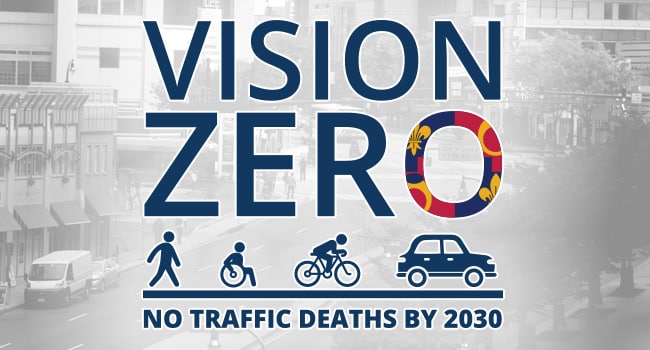
Vision Zero
Posted on May 24, 2018 in Firm News
Since beginning in 2014, Vision Zero has made a noticeable impact on the safety of New York City streets. Last year, NYC saw the lowest rates of traffic-related fatalities since 1910. Between 2013 and 2017, traffic deaths overall dropped 28% and pedestrian fatalities were down by 45%.
Yet, while city officials are throwing up their hands in celebration of the results, safety advocates are putting the breaks on the excitement; 214 lives were still lost in unnecessary traffic crashes last year and 101 of these deaths were pedestrians. The overall goal of Vision Zero is to inevitably reduce traffic fatalities to zero, but some wonder if NYC is doing enough to achieve the end result.
What Is Vision Zero?
According to the World Health Organization, over 1.25 million people die every year from traffic-related deaths; nearly half are motorcyclists, bicycle riders, and pedestrians. As mobility by automobiles has become more widespread in modern culture, so has the acceptance of death when it occurs on the roads.
Swedish safety advocates recognized this harmful trend and came up with a combative plan to prevent vehicle accident fatalities back in 1997- Vision Zero. The idea behind the initiative is to believe that no loss of life is acceptable. Traffic-related deaths are not seen as accidents but as failures in the road systems, which can and should be corrected to prevent future fatalities from occurring.
Vision Zero In NYC
In 2014, New York City Council passed the legislation to initiate Vision Zero in attempts to tackle the city’s growing rate of traffic fatalities and serious injuries. Prior to Vision Zero, an average of 300 people were killed and over 5,000 were severely injured in NYC traffic accidents every year. Based upon the original Swedish design, NYC’s Vision Zero focuses on making streets safer through four main plans of action:
- Public dialogue and education
- Law enforcement
- Street design
- Legislation
NYC Barriers To Vision Zero
New York City officials and community leaders have used the Vision Zero initiative to make several changes since 2014. They formatted Street Teams, enhanced penalties by law enforcement for reckless driving, began the planning process to redesign intersections and focused on passing stronger traffic laws. However, among all of these positive transformations, multiple barriers have stood in the way of NYC hitting the objective of zero traffic fatalities:
- Traffic Congestion: Congestion in NYC is unavoidable, but it is also the cause of thousands of traffic accidents. Congestion can lead drivers to run behind, often times causing them to use reckless and illegal maneuvers to get around other vehicles and pedestrians. Reducing heavy traffic in NYC would lead to a decrease in traffic deaths, however, solutions to reduce congestion (such as congestion pricing) continue to get turned down by voters.
- Devaluing of Pedestrians: Unlike other countries like Europe, American motorists tend to devalue any traveler on the road NOT in a vehicle. Pedestrians and cyclists sharing the road are viewed as pests in the U.S., while in other countries they are seen as the norm, treated with respect and courtesy. Accidents are much more likely to occur if drivers are not sharing or humanizing other transportation methods in NYC.
- Crumbling Public Transportation: NYC’s public transportation is not one to be desired. Fewer commuters are taking the risk of delays, breakdowns, and poorly kept accommodations, opting to drive or use ride-sharing apps instead. This adds more cars on the roads and more opportunities for accidents. Luckily, restorations of the public transportation systems are in the planning process, but it could be awhile until we see the positive effects of these changes.
- Driver Resistance: NYC drivers are always in a rush. And with safety measures such as lowering speed limits, adding speed bumps, and creating slow zones across the city, some advocates believe motorists are more likely to ignore the changes rather than grumble through them.
- Public Protests: There has been significant pushback from certain groups across NYC when it comes to Vision Zero changes, particularly involving added bike paths and reduced street parking. Some oppositions have been so strong, it’s caused city officials to back down on aggressive changes in the Vision Zero plans that involve possible life-saving street redesigns.
Help NYC Meet Zero
Mistakes are inevitable on the roads. Even Sweden has not mastered the idea of Vision Zero, seeing an increase in traffic deaths in 2017 compared to years past. However, safety advocates and supporters of Vision Zero believe the idea to justify a high rate of road fatalities as a cost of living in a metropolitan setting is unacceptable. City officials may have some major challenges ahead of them to reach their goal of zero traffic fatalities but residents of NYC don’t have to sit and wait.
Vision Zero encompasses the idea that every citizen plays a role in reducing fatal traffic accidents. We can drive slower, bike smarter, and be aware when walking to reduce the possibility of accidents. Most importantly, we can continue to spread awareness to others and always look for an opportunity to get involved in the safety of our communities.
You Have A Right To Protection
Municipalities are just as liable for providing safe roads and limited driving hazards as motorists are for abiding by the traffic laws. If you or a loved one have sustained a serious injury from a vehicle accident due to unsafe traffic conditions or negligence, you could be eligible for compensation. Call our experienced personal injury attorneys at Pazer, Epstein, Jaffe & Fein for a free consultation to find out who’s at fault for your damages.
Contact us using our convenient online form or feel free to phone us in New York at 212-227-1212, or in Huntington/Long Island at 631-864-2429.

